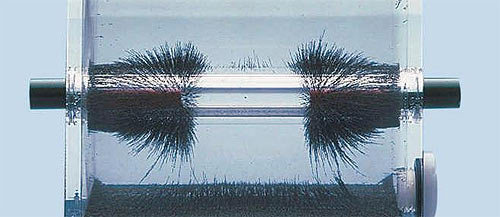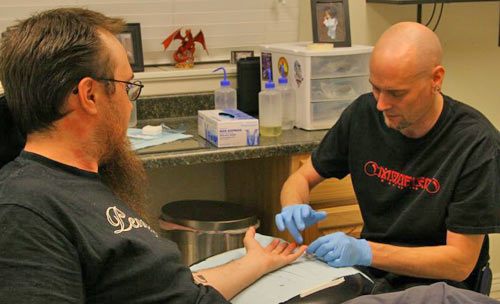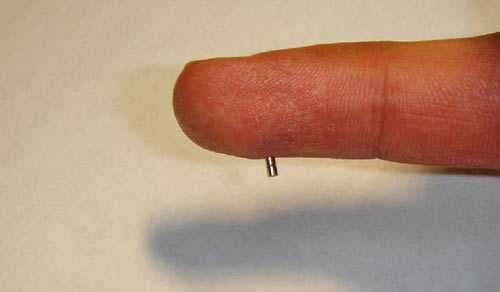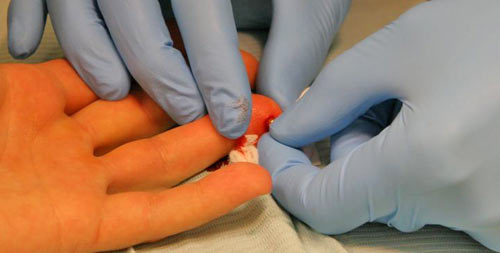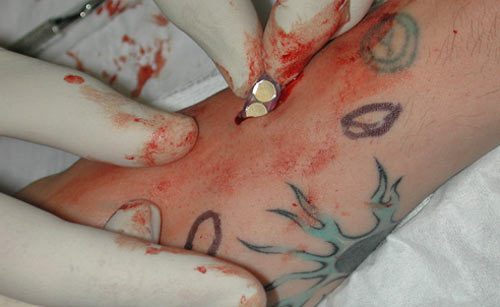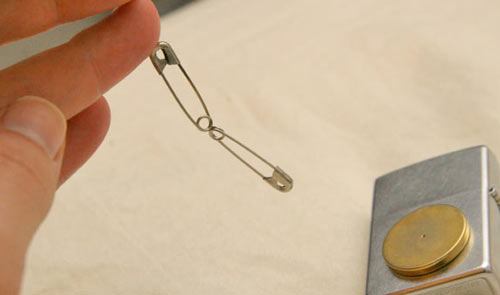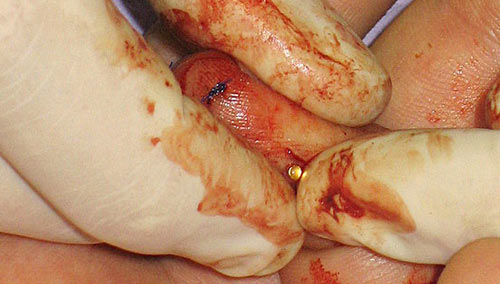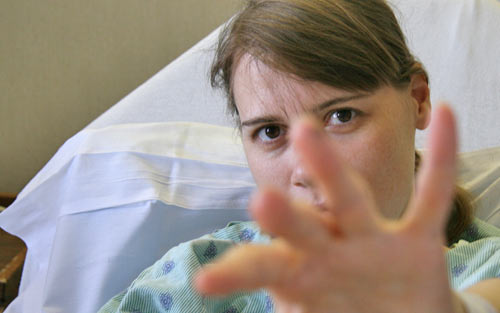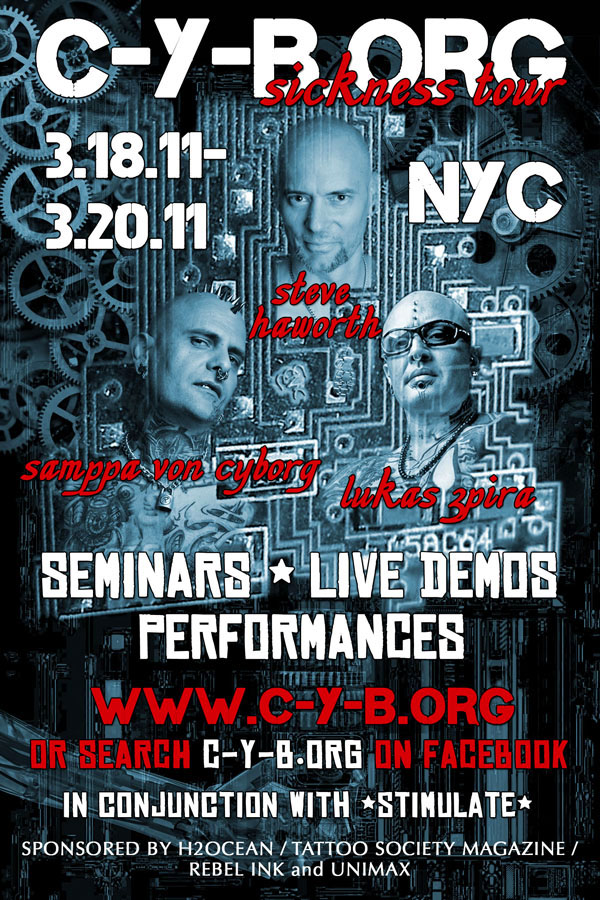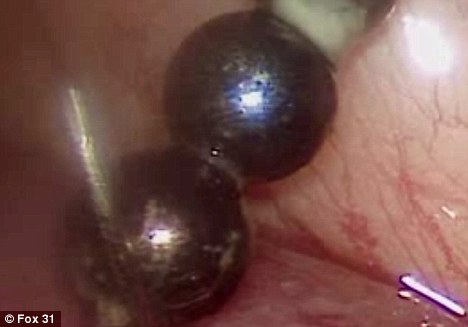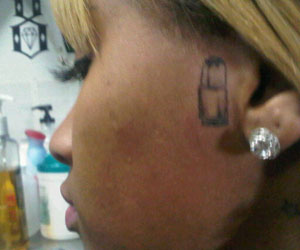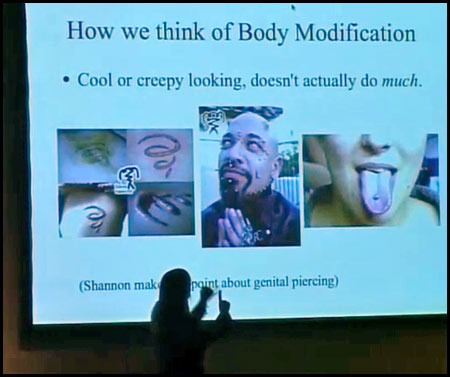
If you don’t already know about magnetic implants, you may want to read our previous articles on the subject, including the original interview about Todd Huffman’s magnets, a six-month retrospective on mine, as well as a magnet risks article with a follow-up by Jesse. In short, magnetic implants are small, encased magnets designed to be implanted in nerve rich areas in order to give the patient heightened sensitivity to EM fields — that is, magnetic vision. Because the magnets vibrate very slightly, the wearer’s senses begin to extend, giving them an awareness of electromagnetic fields and radiation.
In this interview I wanted to talk about the “day-to-day” aspect of having implanted magnets — “what’s it like?” Magnetic implants are still quite uncommon, with possibly less than a hundred people having them. We’ll talk to eleven here — in order of when the magnet was implanted, Todd Huffman ([email protected]) had his done in January 2004, a stack of six magnets in a single case, implanted by Steve Haworth and made by Jesse Jarrell (Mr. Bones), who had a silicone case molded 1/16 length X 1/8 dia N45 NIB installed by Steve a few days later. Steve Truitt‘s magnet was self implanted in mid-2005 (and removed about a year later), and my (Shannon’s) magnets were done at about the same time by Steve Haworth. Also by Steve, Quinn Norton‘s magnet, since removed, was implanted in September of 2005. Jymmi‘s magnet was done in September 2006, and Powder‘s was done a month later, both by Steve Haworth. Fred has a 1/16″x1/16″ neodymiuym magnet implant in a custom made titanium casing (all the others here are in silicone), implanted by Nickk Leading. Anton and Dean were both done in January of 2007, and KYO got his most recently, in April 2007.
When and how did you become aware of being able to sense things with your magnetic implant? Fred: For the first month I thought this was a failure; my main goal was to be able to sense things and I hadn’t sensed anything so far. I work for a company where we manufacture a number of electronic things, and one day my friend was testing a large 230volt power supply with a huge transformer in it so I walked up and waved my hand in front of it and got that cool vibrating sensation in my finger tip. Immediately after I just started putting my finger up to several things I knew had transformers, clocks, cell phone chargers, and microwaves. So far my nebulizer, which I use for my asthma seems to have the strongest field. Steve It was probably two weeks into having it that I started sensing things. I could feel my microwave stronger than anything. Jymmi: I could feel small things at about a week to two weeks, like an electric shaver and a one inch earth magnet. After about three or four months I also could feel the electric fields in my non-magnetic hand. It’s not as strong as my magnetic hand — it’s more of a general feeling. About a month ago I started feeling the vibrations in my feet. Powder: A few days after I had the implant done I was standing in my father’s garage near a large running engine. I felt what I thought was a light breeze on my hand but realised it was only in my implant finger. I started moving my hand closer and farther from the engine and felt slight differences in the sensation. KYO: On the sixth day I picked up an electric sharpener and had a weird sensation — then I realised it was actually the magnetic implant reacting to the electro magnetic field from the engine. Jesse: I tried static fields from large magnets fairly immediately after insertion, but the first really astounding sensation was provided by a power drill. Todd: To quote from my blog, two days after getting the implant:
Dean: The first thing I noticed was while drinking a can of Coke. The magnets themselves obviously weren’t strong enough to pick the can up, but I could feel a slight sensation when holding the can itself. The best way to describe it is a tingling sensation. To date, I am the only person out of the three i know with the implants to get this with a can. Quinn: Right after the implant, Steve passed a magnet close to my finger. I felt it move, and jumped. After that I wasn’t sure which sensations were the healing process and which were the magnet, but as time went on, I was able to distinguish more. Shannon: The first thing I noticed was the drives and fans in my computer. I think I remember a vague buzzing in my fingertips, wondering what it was, and then moving my hands around and realizing that I was sensing definite fields and from that point on it snowballed (although I think they may be becoming less senstive over time — I don’t know if this is due to scarring or demagnetization).
What range of sensation are your magnets capable of? Anton: I can feel rather faint magnetic fields and also electric currents at times, depending on how strong they are. Fred: I can’t feel store security poles, but I have felt a metal detector as I walked through — surprisingly it didn’t go off like I thought it would. I have to have my hand less than a foot away from whatever I’m attempting to feel. Jymmi: I am more sensitive to electrical currents. Sometimes the implant will vibrate or twitch depending on what I walk by. We have these big space heaters at my work, about fifteen to twenty feet up in the air and my whole hand vibrates when those turn on. We also have electric forklifts, and when I get close to the battery chargers it feels like an electric current running up my arm. Steve: I could sense some electrical currents on certain things, especially larger things like my stove or dryer. I could feel certain types of security sensors at some stores. I was never able to feel anything from my computer though. Powder: I can feel different amperages in various cables. I can also tell when a metal is a ferous or not. My favorites are the fields around microwaves (a couple of feet out), AC transformers (a few inches), and fans under the keyboards of laptops (about half an inch above and while typing). KYO: range is hard to define since I find new things on a daily basis. But I’m basicly able to feel the magnetic field around magnets, my computer, some speakers, the oven, some fields around the electric wires (I can actually detect the flaws since the lower protection allows the field to get trough). Jesse: On the lower end I can feel higher power draws through standard 120v insulated power cords (wall power), various functions inside computer equipment(from a distance), magnetism in the more magnetic alloys, on to stronger things like various components of high voltage equipment used in my machine shop, including insulated high voltage leads from a foot or more away, transformers, motors and magnetrons wherever they may exist, store security devices, the stove, and so on.
Todd: Static fields are pretty uninteresting, and need to be pretty large. Oscillating fields I can sense at much lower amplitudes, and are more interesting because they occur more frequently in the real world for things I find interesting. I’ve never quantified the exact range, but I can sense a current running through an insulated wire if there is enough of it. Whatever a power cable to a hair dryer pulls I can sense, and probably about three quarters of that current. Dean: The magnets themselves aren’t that strong, although I am able to pick up tiny pieces of metal and can also use them for various magic tricks in conjuction with my magnetic wedding band ring. The most sensation I get though is when walking through magnetic fields — those sensors they have by shop doors. Again it’s like a tingle within my finger, almost like a sixth sense. Quinn: I felt about three different sensations from my implant. I can’t really describe them very well, but one of them I got consistently from my laptop, and another from electrical cords. The third I felt very rarely… And of course, a fourth: other magnets pulling on my finger. To this day one of the oddest things I have ever felt was the magnet spinning in my finger in response to circling it with another magnet. I tried to practice with it everyday, bring it close to things I thought would be sensable and concentrate on the sensation. After a while it became a comforting and even enjoyable thing. I would pass the magnet over parts of my laptop, and feel them consistently. After a while it helped me feel kind of like all was well with the world. I enjoyed concentrating on the feeling more than I thought I would. I was pleasantly surprised when I would run into unexpected sensations. Shannon: I can barey feel static magnetic fields unless the field is very powerful (such as a large magnet). Vibrating EM fields ranging from spinning magnets in engines (power tools, the fans and drives in a computer, and so on) to any A/C or otherwise fluctuating electrical fields are very easy to feel. Powerful fields like you find in some security systems (especially the type that need to deactivate tracking tags) can actually be quite painful, but essentially an EM fluctuation is just like a physical vibration. So for example, a power cord will have a “buzzing” halo around it that I can feel without touching the cable itself. The size and tone of this field make it fairly obvious what I’m touching.
What are some day to day ways you use your magnets? Anton: I work in a hospital (in the ER) and I can tell if the MRI is in use about fifty feet away from the room. Needless to say, I can’t go in there when it’s on, or it will rip the magnets clean out of my finger — I guess that’s one way to remove them. Fred: I actually use my magnet quite a lot, mostly just to see if stuff is turned on. I am able to locate transformers inside objects and thus detect if they are on. I work in production where I make tons of different electronic components. It’s fun because Im around a lot of huge transformers so it’s interesting to see how strong each of them are. I found a magnet under my bed once by feel alone, even though I wasn’t even looking for that and couldn’t see it. Jymmi: I like to walk around work or through a store or just from room to room in my house and find different places that give off electric feilds — like air conditioners, tattoo machines, and refrigerators. I use my laptop everyday and there are still a lot of fields that I can’t figure out where they are coming from — the disc drive is kind of going bad and everytime it spins trying to read discs it puts off a crazy field. There is a small field around the steering wheel on my car — I can’t figure out if it’s from the metal vibrating. or if there is a magnet somewhere in there. Some cars have it, some don’t. Steve: I didn’t really have any day to day uses other than just being able to sense things. Now that it’s been out for over a year, I can still sense the same magnetic feilds, just not as strongly. Powder: I have used it to find hot cables in a bundle, and sometimes use it to test reed switches in some of the electronics I repair.
KYO: Working at McD, there are the fries that beep once the cooking is completed, and the magnet allow me to know about a second ahead that they will beep since there is a diffrent field that appears to make the alarm go on. Also, my imitation iPod tends to turn off by itself or simply go on pause, and the magnet allows me to know if it’s on or not without taking it out of my pocket. My cellphone is on vibrate, and I’m never sure if it’s my cell or not, but by holding my finger about half an inch away, I can tell for sure if it’s actually the cell that’s ringing. Finally I had used my magnet to troubleshoot a laptop, being able to detect something strange under the keyboard, and the tech did change a card that was located exacly in the area I had spotted the irregularities. Jesse: Immediate awareness of high voltage is very comforting in a lot of ways — there is a reasonable amount of it around me in the shop where I live. Determination of ferrous alloys is frequently handy without having to go look for a magnet. Circuit tracing inside various equipment is often aided by it. Common shop dialogue: unenhanced individual: “Hey, what the hell is thing I pulled off that old assembly line?” enhanced individual: “I don’t know, but its got magnets inside the case here, here and here, I’m guessing the two along that guide rod are for positional sensing, and the one over here is probably a transformer.” An interesting note is that I sometimes get “noise” from it — moving fields with no apparent source. Some of it may be the magnet just “righting” itself after being moved by a previous field or physical force and slowly settling back into a position that fits better with the tissues in my finger, but there have been a few occasions that were not so easily explained away, where I sensed apparent moving fields in open air with no visible source. Todd: Occassionally I use it for diagnostics. For instance, in airports often the power plugs on the walls don’t have power, and I can test them out by just plugging in my power adaptor and feeling for the field — I don’t have to get my computer out. One time I was trouble shooting a water pump, and I could tell that the motor component was working just by feeling the fields, letting me know that the problem was with the pump-shoe thingy. I can also feel my laptop’s hard drive stepper motors, and I like knowing when my computer is moving out of RAM and dropping down into the HD for info. Dean: I usally get most of my day to day use out of the magnet when going in and out of stores. It also helps to tell when certain things are turned on if there no other signs to tell you so. Like my computer monitor… the standby light has broke, but I am able to tell if it’s on standby of not by placing my hand on the screen. Then again though, it really is an old messed up screen. I really should replace it. Quinn: A couple times, in determining if something was live or not. Once, I was able to work out that a demo wasn’t realistic based on the sensation from a cord. Shannon: I’m very aware of power, so for example it’s easy to tell if something is plugged in because I can feel the power leaking out of the extension cord (and I can tell how much power is being drawn — and also tell the quality of the cable assuming there’s a frame of refernece). In day-to-day life, my electric stove has bad connections in some of the burners, so the amount of heat that a given dial-setting generates is different from day to day. Now, instead of using the dial, I just hold my hand an inch or two over the burner and “feel” for the right setting by sensing the amount of power that’s leaking off the coil. It’s actually quite fascinating how EM-saturated our environment is.
Does your magnet have functional (as in non-sensation) uses? Fred: Sadly, I am only able to pick up other magnets and only small things like staples. Anonymous: I’ve gotten laid a number of times directly attributable to the implant. Occasionally a girl on the fringe of my social group will be all like “are you the guy who put a magnet in his finger?” (swoon). Anton: I can pick up very small, very light objects, and move the compass on my keychain — it’s great for bar tricks. Jymmi: The most I can do is pick up screws, paper clips, and bottle caps — or spinning lighters. It really freaks people out when they hold your finger and you move the implant around with another magnet they can feel it moving around under the skin. Steve: It didn’t hvae any functional uses for me, other than some “party trick” type stuff like picking up paper clips or things like that. Powder: I use my magnet to pick up small screws I might drop while working on various electronics. I have used it to single out a cable in a bundle of cables. I mostly use it to do small magic tricks like playing with my compass or rolling other magents around without touching them. When I’m bored I’ll play by swinging a paperclip back and forth. Todd: It has functional use in that it helps me reconceptualize the world around me, and every now and then I say something smart, and that is what people pay me to do. I got into my PhD program solely because of the implant. I was at a conference and some dude was all like, ‘there’s this dude who put a magnet in his finger’ and I was like ‘oh thats me’ and he was like ‘no, really’, and I was like ‘no really’. Then he made arrangements for me to get into my PhD program. Which I promptly dropped out of for sociopolitical reasons but it was pretty cool at the time. Dean Newman I suppose the most use i get out of the magnets again would be when using with magic. Stopping a compass, or sometimes even a watch although that is a lot harder. After a while i was able to use it to “palm” certain objects although nothing bigger than a paperclip.
Why do you think some people report magnetic sensations without the magnet? (Both in new areas, and after removal) Jymmi: I’ve been wondering if you need to have the implant to feel the electric field — if you can train your body to feel it without the implant. It would probably explain why I can feel it in both hands and feet, or maybe i’m just a freak. I think it is real. I’m not sure if it’s nerve density or something biological like high iron in the blood? Todd: I sometimes percieve the magnetic sensation in two fingers, my left ring and pinkie fingers. However, I only have the impant in my left ring finger. I’ve thought about this phenomenon, and here is what I have believe is occuring. In the course of normal finger operation your pinkie and ring fingers often percieve things in parallel. For instance when you grab an ass or run your hands down a woman’s back those two fingers are feeling pretty much the same thing. Your nervous system has limited resources for transmitting information, and uses clever tricks to up the amount of information processing per calorie. Since those two fingers often run in parrallel, at some point for efficiency the nervous system constructed a compression algorithm. The dual finger perception with only one implant is an artifact of that compression. The phenomenon isn’t 100% consistent, I’d estimate 10% of the sensations come up dual. Shannon: I can’t currently sense EM fields in any place other than the fingertip that contains the magnet stack (and the ones that have been removed don’t appear to retain any sesnation), and don’t have any “crossover” between fingers. Quinn: I suspect this is a matter of learning to concentrate. Before I went to Phoenix I designed a test just to make sure it was real, picking out a live wire from 4 choices. We did it double blind back in California with unmodified controls. People actually could pick out the live cord better than the stats would have had it. When I sat down to try it, I could pick out a live cord about 80% of the time, about twice the other controls. We were all surprised, but after talking to some people that worked with electronics, it turned out this was not at all unique. I think it’s entirely reasonable to think that learning to concentrate on AC would let you do it with your skin even without a magnet; though not as reliably. We are, after all, conductive. Please note that magnetic implants are still highly experimental and the underlying encasement technologies and so on are not yet mature. If you want one, please be sure to research and understand the risks in advance!
|
Search Results for: magnetic implant
Post navigation
The Gift of Magnetic Vision [The Publisher’s Ring]

|
It’s hard to deny that Steve Haworth (iam:steve haworth) has been one of the most influential and innovative voices in body art over the past decade. In the field of implants as sculptural art he has singularly defined the art form, and with the assistance of Jesse Jarrell (iam:Mr. Bones) has continued to escalate it into increasingly refined forms. I heard a rumor recently that they’d been experimenting with magnetic implants, and I thought to myself, “cool party trick”, and checked out the pictures on Steve’s page.
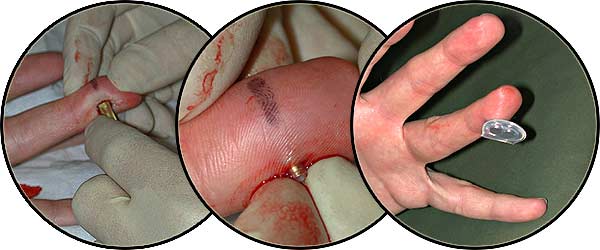
Photos of Todd’s implants being inserted by Steve, and showing them responding to a magnet.
Photos courtesy of Steve Haworth and Jesse Jarrell.
A fascinating letter from the client was posted along with it — he’d had a small silicone-coated neodymium magnet implanted, and it turned out to be far, far more than just a party trick!
|
|
Sensory Experimentation Somatosensory Extension
Reflections by Todd M Huffman [excerpt]
I am now able to perceive magnetic fields in ways not naturally possible. The sensation is different than holding a magnet, as the neurons are stimulated with a higher resolution. With the implant I can detect subtle changes in polarity and strength that I cannot when equipped with a magnet in the conventional manner. Yet the most significant observations have come from another property of implants, their relative permanence to exogenous artifacts. Being able to perceive magnetic fields has expanded my conscious perception of magnetic fields ‘in the wild’.
In one sensory incident, I was walking out of the library, and I sensed the inductive anti-theft device. I have walked in and out of dozens of libraries hundreds of times, and never once have I thought about the magnetic fields passed through me to prevent me from stealing a book. I have been intellectually aware of the mechanism, but never paid attention until now. Another time I opened a can of cat food for my girlfriend’s pets, and I sensed the electric motor running. My hand was about six inches away from the electric can opener, and I was able to sense where the motor was inside of the assembly. Again it brought my attention to a magnetic source that I understood intellectually, but would have otherwise been unaware of. I feel I am one step closer to fully grokking the reality I inhabit.
The experience of my implant is not nearly as rich as my visual or auditory sensation, but nevertheless after a week it has dramatically changed the way I think about my daily sensory experience. A small magnet embedded in a finger may seem like a trivial exercise. I find it difficult to explain the significance, somewhat akin to trying to explain to a blind person what it is to see. The problem isn’t defining the technical characteristics of the visual system, but one of trying to convey what conscious perception of certain wave frequencies does to the way a person conceptualizes the world.
In modifying my body I have ever so slightly altered the way I organize the world in my mind. I eagerly await the day in which I can integrate more elaborate senses into myself. With every passing minute I try to see radiant heat, hear radio waves, and think the thoughts of those that pass by. And by better understanding what I cannot feel, I can fully appreciate what I have now.
I was floored. This seemed to me to be one of the biggest steps body modification has taken. The notion of enhancing sensation is nothing new to anyone with genital modifications, but the idea of adding something fundamentally new to the function of the body is a radical concept that only a few people have done meaningful experiments in. I had to interview Todd about his experiences, and he was happy to help us out.
BME: Tell us a bit about yourself… Where are you from?
TODD: I grew up in Los Angeles and a small town, Teutopolis, in southern Illinois. When I was growing up my main interests were in emergency medicine. I started college studying nursing, with plans to continue on to medical school. While in high school I got my certification as a Nurses Assistant, and completed a course to be an EMT. These experiences are relevant because I was very thorough in my research on body modification, the effects of magnetic fields on tissues, implant construction, and the specific procedural skill of Steve Haworth (the implant artist who worked with me on the project).
I worked as a nurse’s assistant in the St. Louis University Hospital Neurology unit, where I developed my interest in neuroscience — and my aversion to medicine. I don’t dislike the medical profession per se; I just prefer an occupation with more freedom. I moved back to California to attend California State University at Long Beach and studied neuroscience. After graduation I took a job with the Alcor Life Extension Foundation (alcor.org), and will be working there for two years until I start graduate school.
One important aspect of my life is transhumanism. I have been identifying myself as a transhumanist since the age of thirteen, when I discovered the website of the Extropy Institute and the philosophical writings of Max More (maxmore.com) and Nick Bostrom (nickbostrom.com), among others. The transhumanist philosophy has provided a useful framework for me to build ideas and concepts upon, such as the concept and practice of attempting to extend my sensory experience.
BME: Did you have other modifications before this particular “upgrade”?
TODD: Before this my body modifications have been limited to piercing, both cosmetic and play. Our society has perfected the art of pain avoidance and disassociation from our bodies. Piercing and other body modifications bring the mind back to the body and increase a person’s awareness of their physical self. For such a materialistic society, America has lost touch with their physical self.
BME: So this the first “functional” modification you’ve gotten?
TODD: Yes. The magnetic implant is probably the crudest form of functional implant. It pales in comparison to much more complex implants that interface directly with neurons, such as cochlear implants. As a point of clarification, my magnetic implants are more effective as a conceptual tool, rather than for real world use. The plans were more for the exploration of sensory experience than for a specific task that would increase my functional abilities.
BME: For those that aren’t familiar, could you tell us a bit about cochlear implants?
TODD: Cochlear implants are a medical device that bypasses damaged structures in the inner ear and directly stimulates the auditory nerve, allowing some deaf individuals to learn to hear and interpret sounds and speech.
My involvement with cochlear implant research was analyzing the electrophysiological brainstem response of implant patients with a particular disease, auditory neuropathy. I did this for a semester as an independent project, and the bulk of my time was spent in front of a computer working with numbers. However I did on several occasions assist in the data collection procedures, and talked with people who had cochlear implants. I was fascinated with the possibility of gaining a sense with technology that was forbidden by nature.
Fortunately I have all the senses normally accorded to a human being. Current medical devices are not capable of giving me additional sensory experiences. Steve Haworth, Jesse Jarrell, and I were discussing various implants, and Jesse mentioned a friend of his who got a steel sliver in his finger and could sense speaker magnets. Jesse and I had previously discussed implanting magnets, and the idea was born. I was highly motivated to get the implant because of the possibility to explore a new sensory modality.
BME: How did you refine the idea into something functional?
TODD: I spent several months researching magnetic implants. I was concerned the magnet would attract iron particles from degraded red blood cells and cause irritation in the surrounding tissue. A significant amount of research has been done by the medical field and my concerns were alleviated. After that Jesse and I ordered a batch of neodymium magnets from a supplier and played with size combinations. After determining the sizes and shapes of the desired implants, Jesse made several prototypes. Jesse and I tested the implants to make sure the coatings were sufficient, and Jesse made the implant that was actually implanted.
BME: How was the healing?
TODD: Healing was great. I had feeling back by the next morning, and full sensitivity back in a week. The scarring is minimal, and is not noticeable unless you are looking for it. The next day my finger felt like I had slammed it in a car door, but that is expected. There has been no prolonged discomfort.
BME: Is the implant visible?
TODD: Not visible at all. If someone palpates my fingertip and knows exactly where the implant is they can feel it. A friend of mine couldn’t find it until I pointed out the location.
The goal was to have it as unobtrusive and natural as possible. The reason for this was not to hide the implant from other people, but to hide it from myself. I want the sensation to seem as naturally endogenous as possible. I want the sensation to integrate as much as possible with the rest of my sensory experience.
BME: How does it feel to you in the absence of a magnetic field?
TODD: I feel nothing, just like any finger experiencing normal conditions. Humans ignore the majority of sensory experience, a necessity given the barrage of information thrown at us by reality.
BME: And when you move into a magnetic field, what does it feel like?
TODD: There are two distinct feelings I get from fields. For a static field, like a bar magnet, it feels like a smooth pressure. Imagine running your hand slowly through lukewarm water, and brushing your finger across the top of a large invisible marshmallow. That is the closest description I can give. Oscillating fields, such as electric motors, security devices, transformers, et cetera, vibrate the magnet. This sensation is much more sensitive and noticeable.
BME: How sensitive is? Can you tell the direction of a field?
TODD: The implant is rather sensitive. I can tell the polarity of a bar magnet from several inches away. So far the furthest I have felt an oscillating field has been about two and a half or three feet. That was the security system in a video store, which uses magnetic induction.
BME: You can “feel” for anti-theft devices? You’re getting all the super-villains excited!
TODD: All you would-be criminals don’t get your hopes up. I can only detect the active components of anti theft devices — those stands by the exits of stores. The actual component inside the item does not generate its own field. I just get a buzzing feeling when going through security systems.
BME: How “fine” a sense is it? Does it feel like a sense like sight or hearing, or more like a “sixth sense” in that it’s more of a “gut” or instinctual sense?
TODD: The feeling is rather fine. I can detect different frequencies in the magnetic fields. I haven’t done experiments yet to determine the sensitivity range, but I will in the near future. The sensation is rather intuitive, and exploring a magnetic field is not unlike trying to identify an object with your eyes closed.
BME: Does it feel like a sense in and of itself, or is it more of an “interface” between a sensory device and your nervous system?
TODD: The implant does not feel like an ‘alien’ artifact, it is much closer to a natural sense. When the sense is not active I don’t feel the implant and don’t really think about it. If the sensation were coming from an external source, it would feel much more like an interface object rather than an actual sensory experience.
BME: Will you expand this to your other fingers as well, or do you feel that wouldn’t add to the experience? I’m having visions of mechanics that will be able to run their fingers over an engine and diagnose problems because of imperfections in the magnetic fields.
TODD: I don’t think this type of implant will ultimately prove to be useful. However, my intentions were exploratory, and the case may be that this type of implant has many more uses. There are a few ideas I have that may involve adding more implants.
BME: Do you have plans to add other senses as well?
TODD: I would like to add as many senses as I possibly can. One area I am considering is using the implant, and others as needed, as a form of haptic feedback. Computer interaction is developing at a snail’s pace, whereas almost every other index of computer development is racing at exponential rates. Our main form of computer input — the keyboard — is over a hundred years old. Even the mouse is over thirty years old. Monitor technologies have progressed very slowly, and are fundamentally the same as they have always been. I don’t expect everyone to go out and get magnets implanted in their fingers, but as a society we need to think outside the box and devise new ways to interact with computers.
BME: Are you finding that it is having a functional impact on the way you perceive and interact with the world?
TODD: The implant has changed my perception of the world around me in a small but significant way. Information is constantly flowing around us, and we remain blissfully unaware of most of it. Having a tiny bit of that data stream pulled into your conscious awareness is a shocking experience. Functionally I have changed very little, but I am now more aware of what it is I don’t feel. There is an untold amount of information flowing around us that we don’t experience; my implant makes me think about this more.
BME: Did you do any psychological (or other) preparatory work before the implant?
TODD: Before the actual implant there were several months of planning and hypothesizing, and thus I was well prepared for the procedure and the implant. There were unexpected sensations, and some sensations were missing I thought would be noticeable. I can’t say I would recommend any particular preparation, as a person willing to put implants into themselves should be able to handle small changes in their sensory paradigm.
BME: Can I ask a little about your research work for Alcor, and how that relates to this implant?
TODD: Alcor and the body modification community have a lot in common. The classic members of both communities are individualists with strong personal identities. Neither group is afraid to push the envelope of what is accepted by the populace around them. Transhumanism is a philosophy that does not encompass all members of both communities, but I have noticed a significant level of overlap. I think this is the case because transhumanism as a philosophy encourages exploring boundaries and transforming yourself.
Alcor employs me as a Research Associate, and I am part of the research and development team. My main task is to research and evaluate methods of preserving and storing neural tissue. My research at Alcor is unique because no other organization is concerned with preserving tissue in the manner we are. The research is significant not only to cryonics, but a lot of our research has applications in other areas, such as organ transplantation and storage.
All of this ties together because ultimately I am interested in pushing the boundaries. Pushing boundaries is, in my opinion, the quintessential characteristic of humankind. An a priori acceptance of the status quo on the part of our ancestors would leave you and I as naked apes hiding in the trees, or more likely, extinct. Both cryonics and body modification are controversial and exciting, just like writing or forging metal or flying.
BME: How did you meet Steve and Jesse, and what made you decide to work with them, rather than working with a doctor or more traditional medical team?
TODD: Jesse I met at a Los Angeles Futurists meeting, where we were attending a talk by Syd Mead. Later I met Steve through Isa Gordan, an artist in the Phoenix area.
As Steve and Jesse became friends with me, we discussed body modification and my medical background, and Steve allowed me to observe several procedures. Steve’s protocols for infection control and cross contamination avoidance are on par with a hospital setting, and I felt confident in his technical abilities. In addition, there is a high level of artistic vision in implant work, which I do not think can be met by conventional medicine.
BME: So there were advantages to doing it without the constraints of the medical industry?
TODD: Steve and Jesse provide the professionalism and concern for safety provided by traditional medicine while incorporating artistic vision and skill. Doctors, even cosmetic surgeons, would have likely shied away from doing this type of implant work. The fear of the unknown would dissuade most doctors from assisting me in the project.
BME: Any advice for people considering adding this sense or others?
TODD: Exploring sensory experience is a fundamental quality of human beings, be it through implants or pharmaceuticals or technology. Before any experimentation you are obligated to yourself to perform thorough research into the subject, as it is very easy to harm yourself. Personal responsibility is even more important than experimentation.
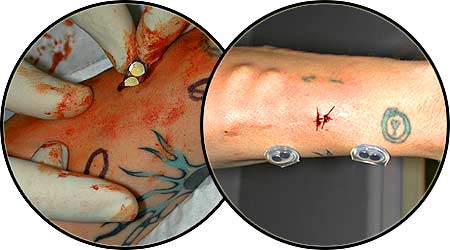
Jesse’s own magnetic implants, for utility rather than sensation.
Photos courtesy of Steve Haworth and Jesse Jarrell.
Thank you to Todd for taking the time out to talk to us. If you’d like to contact him, you can do so via email at odd1 at onebox.com. If you are looking to have this procedure or one like it done yourself, contact Steve Haworth via stevehaworth.com.

Shannon Larratt
BMEzine.com
Biohackers: A Journey Into Cyborg America
“I just want to see how far I can push the human.”
The Verge has just posted a very fun little documentary on “Grindhouse Wetwares” and other groups working on functional implants and “scrapheap transhumanism” (love that term), as well as some great coverage of magnetic implants and things like that. It’s a bit over ten minutes long and lots of fun. Set some time aside and check it out. I have to be honest that I am not terribly impressed by what has been done so far, but these are baby steps being taken, and I hope that even if it falls far short, I’d like to think it will inspire people to go further and do it better.
Stuck on Oreos
Keep your eye on the Oreo. You are getting sleepy.. sleepy.. very very sleepy.
Ok, so maybe xFBx isn’t trying to hypnotize you with a cookie, but he is enjoying his magnetic implant that was done at First Blood in Sydney, Australia.
ModBlog News of the Week: March 11th, 2011
I’m beginning to hate that every week there is a new disaster to report. By now you’ve heard about the earthquakes that have been rocking Japan since last night, as well as the devastation that the tsunami’s have been doing to the coastal cities. The worst news is that the quakes still haven’t ceased. Following the 8.9 last night, there have been a number of aftershocks as well as 2 new earthquakes that occurred this afternoon. While it is still to early to know the extent of the damage, if you have friends or family in the affected areas, or you yourself are in Japan right now, our thoughts are with you. Google’s appspot has set up a person finder for Japan, which should hopefully help those who haven’t been able to get in touch with their loved ones. As always, the Red Cross is on scene and providing aid as they can.
It’s in times like these that people can come together from all walks of life to help others. A number of years ago artist Shelley Jackson put out a call to the world for people who would be willing to get a tattoo of a word on their body in order to form a story. Since that time people all over the world have come together, bound by the power of words and skin, to contribute to her project. While it isn’t finished, Shelley recently put together a sub-story, using videos submitted by the owners of the tattoos.
“Shelley Jackson’s story ‘Skin’ exists only in the flesh — the flesh of about 2,000 volunteers. In 2003, when she wrote the story, she called for participants to each be tattooed with a single word (some also get a bit of punctuation, like ‘ankles,’ with the comma included). The story has never been published in any other form…[For] the Berkeley Art Museum, Jackson has cut together video footage from a small set of participants to tell a new sub-’Skin’ story. Recently Jackson e-mailed them to ask that they record a video of their word tattoo, and to say the word. From those words recorded by participants, she’s edited and assembled a new story.”
This week is pretty light on the real news, but ridiculously heavy on the celebrity news. So strap yourself in for a wild ride that includes Julia Roberts, Pee-Wee Herman, and some tiger’s blood.
To kick things off this week is an announcement about an upcoming seminar in NYC. For one weekend in March, you can have the opportunity to attend classes and witness performances by a trio of body modification artists.
It is our great pleasure to present to you an opportunity to be a part of something paramount! For the first time in a decade, the most innovative minds of the body modification community have come together to form a collective consciousness: C-Y-B.ORG. Its goal: to educate, demonstrate and liberate our community. Body modification pioneer Steve Haworth has rejoined forces with two of the top practitioners of today and the future, Lukas Zpira and Samppa Von Cyborg. Together they are C-Y-B.org. This event will give the opportunity for those yearning to learn the art of body modification. Through seminars, workshops and live performance, including but not limited to magnetic implants, branding, scarification, tongue splitting, flesh stapling, and suspension.
If you’ve got an event coming up, feel free to drop me a line and let me know about it.
We’ve seen in the news countless stories of schools banning facial piercings. Well some kids thought they found a loophole by using rare earth magnets to fake a tongue stud. While great in theory, it turns out that if you accidentally ingest several magnets it will end up doing some major damage.
The tiny ball bearings – known as ‘buckyballs’ – are sold as an executive desk toy which can be moulded into any shape. But some teenagers are using them as fake tongue rings to make it look as though they have a piercing. If swallowed, the balls can cause serious damage, burrowing through the small intestine. The packaging warns of the danger, and says they are not suitable for children.
Lauren, who lives in Wheat Ridge, rung her mother last week in tears, complaining she couldn’t walk because of an intense pain in her side. She said: ‘They bounced off my tooth and went down my throat, and I couldn’t stop it.’ Lauren is now in hospital recovering after an operation to remove the magnets. Her surgeon, Dr Saundra Kay, told the channel: ‘You have one strong magnet in one loop of intestine, another magnet in another loop of intestine, and those magnets are so strong that they will bring those intestines close together and the two loops joined.
So just to review, magnetic implants: good, swallowing magnets: bad.
One of the most often questions modified people hear is “did it hurt?”. Well it turns out that when you get a tattoo removed, it also hurts. No big shock there, but what is surprising is that tattoo removal can come with some pretty nasty side-effects beyond pain. Because of this, the FDA is holding a “webinar” next Tuesday to educate people about the dangers of tattoo removal.
The inks and pigments applied in tattoos can cause allergic reactions, infections and scarring, according to the U.S. Food and Drug Administration (FDA). Also, tattoo removal process is not as great as it seems. FDA will be holding a 30-minute tattoo safety webinar at 1 p.m. CT on March 15. Bhakti Petigara Harp, a specialist from the agency’s Office of Cosmetics and Colors, will discuss potential problems, along with the misrepresentation of the inks and pigments as “FDA approved.”
What a lot of people don’t know when they get tattoos is how painful they are to remove, Shamontiel Vaughn. Some say laser removal feels like the snapping of a rubber band against the skin. Vaughn, who spent about hundreds of dollars getting one tattoo and three cover-ups removed, called the process of laser tattoo removal “insane.” “Each time I got laser surgery, there were a bunch of small bumps that resembled keloids, rock hard skin and a little bit of bleeding,” said Vaughn. “I made the mistake of falling asleep on that arm the day after surgery, and I woke up and thought something was crawling on me. It turned out that my arm went completely numb. I woke up screaming and jumping around trying to get my own arm off of me because it’d turned into dead weight. After I turned on the light (while still jumping around), the feeling slowly came back into my fingers,” concluded Vaughn.
It seems as though tattoo removal is not as fantastic as it is often portrayed. It is not only pricey but also very painful. The FDA’s 30-minute tattoo webinar will be held Tuesday, March 15 at 1 p.m. (CT). You’ll have a chance to ask questions at the end.
In case you weren’t aware, spring break is happening next week. This also coincides with the annual “go get drunk and tattooed/pierced” week. I’m sure it’s just a strange coincidence. In any case, universities are starting to pay attention and are putting forth efforts to educate students about safe practices, so that when they’re completely smashed they won’t get pierced with the same needle that the 10 people before them were pierced with.
The last thing on a college student’s mind during spring break is contracting HIV, Hepatitis C or Tetanus. Who would have thought that getting a spur-of-the-moment tattoo or piercing could leave not just a mark but a life-long disease?
On March 8, the Office of Counseling and Student Development and Student Health Services passed out information to students about body art safety and how to protect one’s self over the break. ”Stamped and Stabbed” offered the soon-to-be spring breakers pamphlets and brochures on the harm that coincides with tattoos and body art. ”They [students] tend to rush into things during spring break. We’re here to get students aware of what consequences they can face as they jump into getting a tattoo or piercing,” says Joy Wunderlich of the Office of Counseling and Student Development.
“Students meet a girl or guy, get their name tattooed and then realize the next day that they’ll have to explain to their future spouse whose name is tattooed on them,” said Williams. As students departed with information on body art safety, they were given a temporary tattoo as a reminder to make appropriate decisions during spring break.
And with that, we’re on to the celebrity round-up.
To kick things off Ke(dollar sign)ha, has expanded her clientele of tattoo customers beyond her band to include fans.
A big fan gets a Ke$ha tattoo. A SUPER fan gets a tattoo from Ke$ha. Well, a SUPER fan who is okay with having a subpar tattoo gets one from Ke$ha, anyway. The singer posted this video to her Facebook profile of herself marking up a dedicated fan with her safety pin, giving her dollar sign to the emotional, fawning fan.
Last week we saw rapper Yung LA get a duck tattooed on his face in honor of his new record contract. Well it seems he jumped the gun, as the record label never actually offered him a contract. The quick thinking Mr. LA rushed out to a studio and covered up his already fresh duck with an LA Dodgers logo.
Not to be outdone by the boys, “femcee” (their word, not mine) Diamond also joined the facial tattoo club with a tattoo of a bullet.
The rapper debuted some new ink on Tuesday (March 8), via Twitter (@DiamondATL), posting a pic of her new face tattoo of a bullet with the accompanying message: “IN LIFE: You only get ONE SHOT!!!!!! Remember dat!”
In happy news this week, Avril Lavigne has promised to not get any more tattoos for a while. So for the next little while the celebrity round-up will be Avril free!
In other bad pop singer news, Britney Spears has gotten in shape and did a photo shoot. Supposedly the fact that she’s showing off 10 year old tattoos is a shock to some people.
Pee-Wee Herman made an appearance on Lopez Tonight earlier this week and was stunned to find out a woman in the audience had a Pee-Wee tattoo. I think the real news here is that Pee-Wee was actually shocked to see little Pee-Wee sticking out in the audience. You’d think he’d learn his lesson by now.
Someone sent Charlie Sheen a bottle of tiger’s blood. To celebrate he got “Winning” tattooed on his wrist. I can’t make fun of this at all. I truly believe that Charlie Sheen is winning. What he is winning has yet to be determined, but he’s definitely winning something.
And now the story you’ve all been waiting for, because including Julia Roberts in a ModBlog news post is something of a special event, a man has come forward to show off his love and devotion to Julia. By getting her portrait tattooed on his body 82 times.
Film buff Miljenko Parserisas Bukovic enjoyed one of the actress’ films so much he got 82 tattoos of her FACE permanently etched all over his body.
Miljenko – a newspaper vendor in Mexico – has covered himself from head-to-toe with the pictures. He splashed out HUNDREDS of pounds on the tattoos after seeing Roberts in her film Erin Brockovich.
So what was that you were saying about the woman with a bunch of Robert Pattinson tattoos?
That’s it for this week everybody. Remember to keep sending in those links to news stories the world over.
Have a safe spring break, to those in college, and for those affected by the disaster in Japan, please drop someone a line to let them know you’re alright.
Magnets, how do they work?
Apologies for the ICP lyric, but it’s been a while since we’ve had a story about magnetic implants I couldn’t help myself.
Rata, from Rata Body Art Studio in Buenos Aires, recently spent a couple of months working in Florida as a guest artist. On his last day in Florida, Pinhead and Johnny Vilonius decided to surprise him by giving him some magnetic implants as a parting gift. Rata has had his work featured on ModBlog before a couple of times, but I believe this marks the first time that he’s been the subject of the photo, not the artist behind the work featured.
Thanks to Johnny for sending in the photos. According to him the procedure only took 10 minutes, and he was on a plane back home the very next day. The first image is of Rata looking at his fingers, and the second is of Pinhead inserting the magnets.
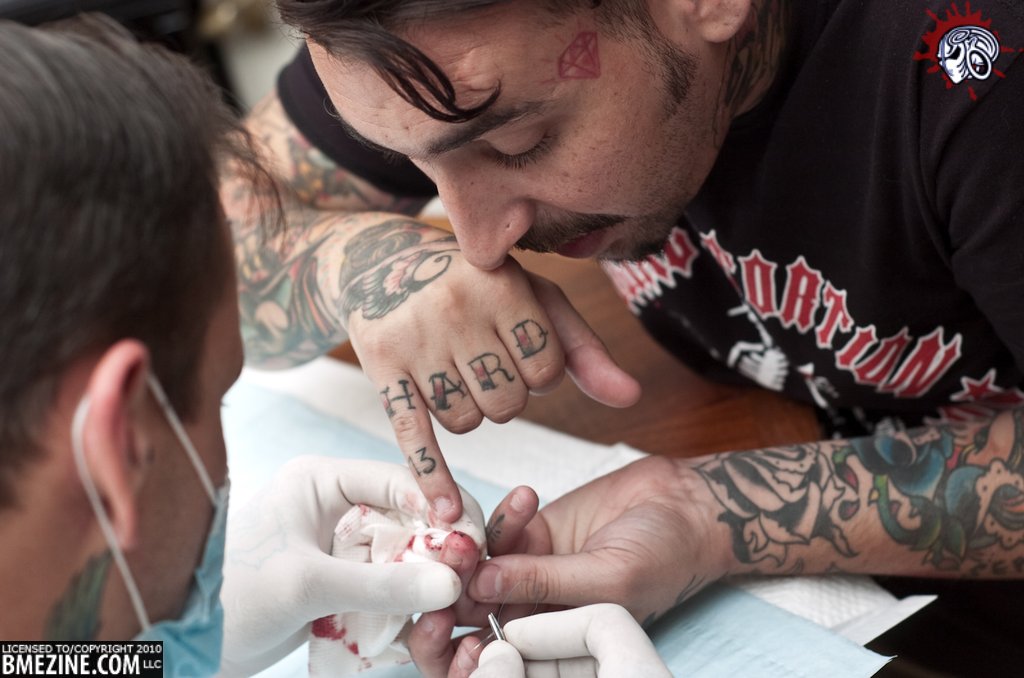
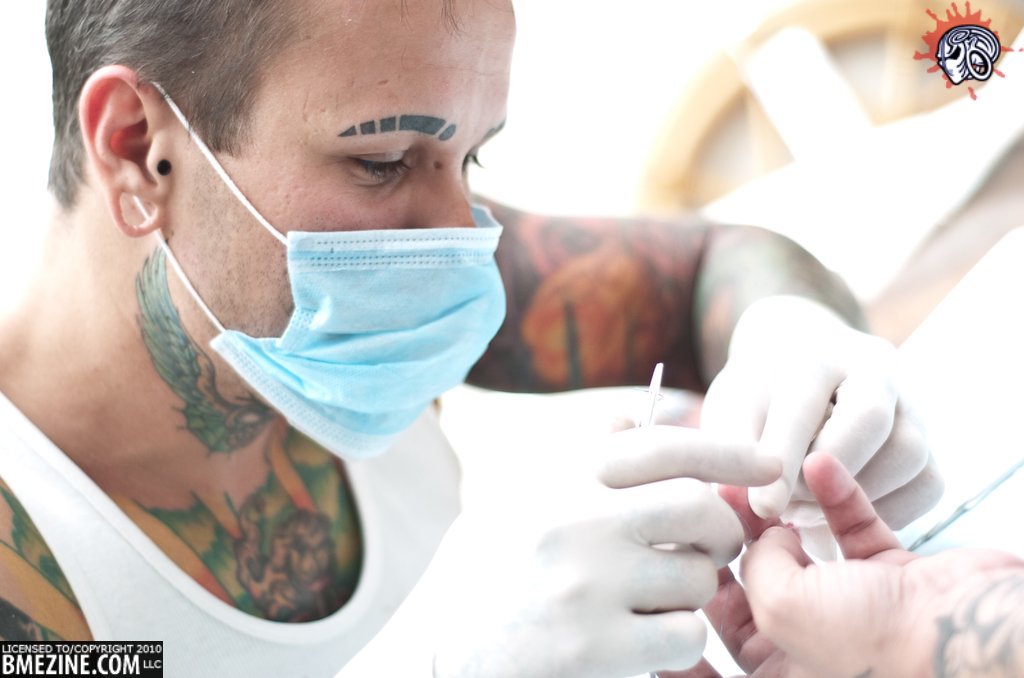
You can check out the rest of the images in the discreet implants gallery.
You wouldn’t buy a car without a test drive….
..so why would you get magnetic implants without giving them a try right away?

These magnetic implants were done by alienboy, who you may remember from one of his many modblog features or this interview.
On a side note: These magnetic implants were a fairly recent submission so I assume they are the newer generation of magnets that have not been known to have the same coating failure issues the initial batch did.
BMXnet Recap
Leave your bikes at home, folks – this is Germany’s premier Body Modification eXchange Conference.
Sure, the BMX reference is long since played out, but I must admit the first time I heard mention of “BMX network,” I envisioned a German X Games for modified people; for those that attended, some might agree that some of the performances qualified on that front. But I’ll get to that in a bit. For now, sit back, relax, keep reading and we’ll get to all the gory details soon enough.
 |
| The Saviours, Jussi and Lassi |
So, where do we begin? How about this: It was hot. And not in a Paris Hilton-esque “that’s hot” sort of way. No, I’m talking about sleeping-on-top-of-the-sheets, butt-ass-nekkid-with-the-windows-wide-open hot. Don’t get me wrong, I’m a Texas boy that loves to vacation in the desert — I like the heat. (Although, I also like my air conditioning — something of which Germany and most of Europe has very little.) Actually, it was quite amusing how easily you could spot the Americans: We were the ones sweating to death and drinking copious amounts of water. If nothing else, you can say one thing about Europeans — they’re an adaptive people.
Then again, you would have to be. With so many different languages and peoples all coexisting, Europe is quite the incredible mixture of culture, innovation and ideas. Heat be damned, Germany was a perfect place to hold a body modification conference, even if it was in the middle of nowhere.
In all my international travels, I’ve learned one simple fact: Almost everyone in the world’s modern cities speaks English — so, as an American I’ve always had it easy. And, sure enough, the BMXnet conference catered to English speakers. Yes, there were many classes labeled “German Only.” But, fortunately for those non-Deutsch speakers, the organizers had interpreters on hand to translate via headphones. Granted, the system wasn’t perfect: Technical terms were often difficult to translate, and there were times when the lectures were better heard in the native tongue. But, overall, the information flowed smoothly and everyone came out better informed from the experience — and what an experience it was.
BMXnet was not a tattoo convention, nor even APP meets the EU. This conference was purely educational, with very little of the party atmosphere we’ve all come to expect from modification conventions. Which isn’t to say it wasn’t fun; there was, of course, plenty of socializing and some quiet debauchery that those who were there might speak of in blogs and forums … but don’t hold your breath. What happened in Germany stayed in Germany — unlike Vegas, where the pictures seem to hit the Internet only moments after the deed has been done. Plus, this crowd seemed a bit different. Rather than the week-long drink-fests I’ve attended in the past,this event seemed a bit more polished. The days were structured like college lectures and the nights were filled with some very cutting-edge entertainment.
 |
| Havve of Pain Solution |
You may have seen some of the images featured on ModBlog or the hundreds of images in the BME gallery, but photos and even the small bit of video that are floating around really do not do the performances justice. Operafication put on a show featuring suspension and Hilary’s beautiful operatic singing and visual imagery that as always, moved the audience. Pain Solution, with Havve’s quirky humor and some new twists on some classic sideshow acts, was definitely a crowd pleaser. Samppa von Cyborg put on a performance that was best described as bizarre and somewhat disturbing, but in this writer’s opinion, The Saviors stole the show. How, you ask? My friends, photos are worth a thousand words. (I’ll let ModBlog do the talking on that front, but … poor, poor Lassi.) Good times, folks, good times — but I digress. The real reason we were all there was for the convention itself.
BMXnet was an incredibly well structured, highly organized event dedicated the sharing of information pertaining to the body modification industry, hence the name Body Modification eXchange Network. During the day, the lectures and demonstrations all flowed like a well-oiled machine. There was a small area where vendors sold supplies, equipment and even a decent selection of body jewelry. However, the main focus was on the classes. Every attendant was an established body art practitioner that was there to teach, share ideas, learn and ultimately network. Yes, there were older, fairly famous people that many people considered mentors, but generally the participants viewed each other as equals. In every class I attended, the audience sat attentively, soaking up all the information and asking well-informed, highly intelligent questions. The general attitude was definitely serious, but also pleasant and relaxed at the same time. Of course, there were some differences of opinions, but everyone listened and there never seemed a point when voices were raised or egos were bruised. In fact, I know this may sound hard to believe, but I swear I sat amongst several hundred well established and highly acclaimed body modification professionals and for the most part there seemed to be no ego at all.
 |
| Hillary of Operafication |
With any good review there should always be positive and negative points. However, it’s honestly hard to find problems. There was a free buffet available all day. Beds — yes, beds — were set up in different areas for people to sit and relax; I managed a quick nap while waiting for the magnetic implant lecture. We were even shuttled back and forth from the hotel to the venue. Truly, the crew of BMXnet were very gracious hosts that went above and beyond the call of duty to make everyone feel comfortable and welcome. If I had to point out any potential changes for next year, it would be the input of more opposing views. Maybe we have just evolved as an industry, or possibly it’s that Europeans are so courteous, but this author loves nothing more than a good high-spirited debate. Yes, I’m known for being the devil’s advocate, and I do have a history of provoking arguments. However, there is a method to the madness. If there is one thing the body modification industry has been guilty of doing, it’s accepting knowledge without question.
Doubt me? Well, here’s a simple fact that was often discussed during the conference. Over 95-percent of the world’s piercings that are done with threaded jewelry are healed using externally threaded jewelry. Now, it has been commonly accepted — at least by the Association of Professional Piercers, of which I am a founding member — that only internally threaded jewelry is suitable for new piercings. Sorry, the numbers don’t lie. Yes, there are many factors that make one piece of jewelry better than another, and I still stand by the quality of several of the internal manufacturers, but it’s time to look at the statistics and accept the facts. The days of, “We’ve always done it this way” and, “This is how we were taught” are long since over.
[Steps off the Soap Box]
OK, it may seem that this article has gone off course, but nothing could be further from the truth. Statements like the paragraph above were the true foundation of BMXnet. We were there to challenge each other. Once you know it all, there is no more room to learn, and if there’s one thing this experience has taught me, it’s that there is so much experience and knowledge that far surpasses my own. I went to teach a class on Laser Tattoo Removal, co-present a suspension safety seminar and further participate in a suspension roundtable, but I walked away with so much more.
There were questions asked that made me rethink many of my fundamental ideas of both my past experiences and my future direction. I saw many new techniques and learned interesting new facts on topics I once thought there was little left to know. I watched amazing practitioners work and put faces to names that were once just photos in magazines. I got to know colleagues that were at best acquaintances, and earned new respect for people I have known for many years. I gained more confidence in my personal accomplishments and was humbled by the skills of others. Treated as an equal and indulged like a guest. If you can stand the heat, this is the best kitchen this author has visited in a while.
Spider Man.
Fred‘s recently been getting involved with his local indoor climbing club (that’s chalk, not cocaine) and adds “It just goes to show that even with a magnetic implant, you can still use your fingers to their fullest!”

That said, there are still a lot of risks involved and much more research to be done on magnetic implants.
Body Hacking Talk
For those that didn’t see the links on boingboing yesterday, Quinn posted her slides from the talk, and there’s also a video of it that you can watch. The slides are probably old news for anyone that’s been around BME for a while, but the video of the talk is very interesting and while it covers functional modification (Quinn also has magnetic implants), I found her comments on cutting and other things in that realm very insightful.
